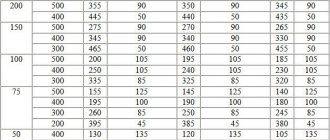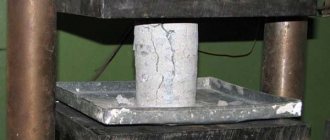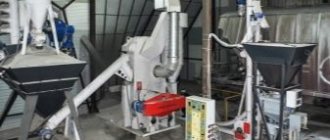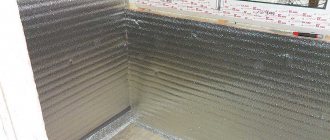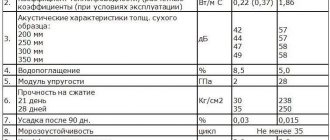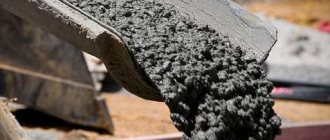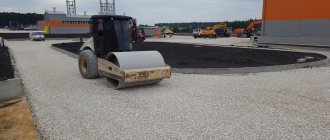Preface
The goals, basic principles and basic procedure for carrying out work on interstate standardization are established in GOST 1.0-2015 “Interstate standardization system. Basic provisions" and GOST 1.2-2015 "Interstate standardization system. Interstate standards. rules and recommendations for interstate standardization. Rules for development and adoption. updates and cancellations"
Standard information
- 1 DEVELOPED by the Research, Design and Technological Institute of Concrete and Reinforced Concrete named after. A.A. Gvozdev (NIIZhB named after A.A. Gvozdev) - a structural subdivision of the Joint Stock Company "Research and Development (JSC "National Research Center "Construction")
- 2 INTRODUCED by the Technical Committee for Standardization TK465 “Construction”
- 3 ADOPTED by the Interstate Council for Standardization, Metrology and Certification (protocol dated March 29, 2022 N® 117-P)
The following voted for adoption:
| Short name of the country lo MK (ISO 3166)004—97 | Country code according to MK (ISO 3166) 004-97 | Abbreviated name of the national standardization body |
| Armenia | A.M. | Ministry of Economy of the Republic of Armenia |
| Kyrgyzstan | KG | Kyrgyzstandard |
| Russia | RU | Rossgandart |
| Uzbekistan | UZ | Westamdart |
- 4 By Order of the Federal Agency for Technical Regulation and Metrology dated June 6, 2022 No. 296-st, the interstate standard GOST 27006-2019 was put into effect as a national standard of the Russian Federation from January 1, 2022.
- 5 INSTEAD GOST 27006-86
Information about changes to this standard is published in the annual information index “National Standards”, and the text of changes and amendments is published in the monthly information index “National Standards”. In case of revision (replacement) or cancellation of this standard, the corresponding notice will be published in the monthly information index “National Standards”. Relevant information, notices and texts are also posted in the public information system - on the official website of the Federal Agency for Technical Regulation and Metrology on the Internet (www.gost.fu)
© Standardinform. decor. 2019
In the Russian Federation, this standard cannot be fully or partially reproduced, replicated and distributed as an official publication without permission from the Federal Agency for Technical Regulation and Metrology
GENERAL PROVISIONS
1.1. The selection of concrete composition should be made in accordance with the requirements of this standard in order to obtain concrete in structures with strength and other quality indicators established by state standards, technical specifications or design documentation for these structures, with minimal consumption of cement or other binder.
1.2. Selection of concrete composition includes: determination of the nominal composition, calculation and adjustment of the working composition, calculation and transfer of working dosages to production.
1.3. The selection of the nominal composition of concrete is carried out when organizing the production of new types of structures, changing the standardized quality indicators of concrete or concrete mixture, production technology, suppliers, type or brands of materials used, as well as when developing and revising production standards for the consumption of materials.
1.4. Working compositions of concrete are prescribed during the transition to a new nominal composition and then upon receipt of new batches of materials of the same types and grades that were accepted when selecting the nominal composition, taking into account their actual quality. When prescribing working compositions, they are tested in laboratory or production conditions.
In the future, based on the results of operational quality control of materials from these batches and the concrete mixture obtained from them, as well as acceptance control of concrete quality, adjustments are made to the working compositions.
1.5. The working dosage is prescribed according to the working composition of the concrete mixture, taking into account the volume of the prepared batch.
1.6. The selection of concrete composition must be carried out by the laboratory of the concrete mixture manufacturer according to an approved specification developed by the technological service of this enterprise.
It is allowed to select the composition of concrete in central laboratories, Orgtekhstroy trusts, research laboratories and other organizations according to the approved specification for the selection of concrete composition.
1.7. The results of selecting the nominal composition of concrete that meets the requirements of the approved specification must be documented in the concrete composition selection journal and approved by the chief engineer of the concrete mixture manufacturer. Working compositions and dosages are signed by the head of the laboratory or another person responsible for selecting the concrete composition.
1.8. The task, the journal for selecting the nominal composition of concrete, lists of working compositions and sheets of working dosages, together with duplicates of quality documents for the corresponding batches of concrete mix or structures, should be stored at the manufacturer in accordance with the requirements established by GOST 13015.3 for a quality document.
Content
- 1 area of use
- 2 Normative references
- 3 Terms, definitions, symbols and abbreviations
- 4 General provisions……………………………………………………………………………………………………………………………………….
- 5 Task for selecting the composition of concrete…………………………………………………………………………………………………………….
- 6 Selection of the nominal composition of concrete……………………………………………………………………………………..
- 7 Purpose and adjustment of working compositions of concrete…………………………………………………………………………………
- 8 Transfer of working concrete compositions to production………………………………………………………………………………….
Appendix A (recommended) Form of map for selecting the composition of heavy concrete……………………………..
Appendix B (informative) Development of production compositions of heavy concrete
M M OF (ON
at the concrete mixing unit………………………………………………………………………………..9
Bibliography………………………………………………………………………………………………………………………………………11
Selection of the composition of heavy concrete
The correct design of the composition of heavy concrete determines its density and strength, which, in turn, largely determine such important properties as frost resistance, water resistance, etc. A rational composition of heavy concrete is considered to be one in which the binder consumption is minimal, subject to obtaining a given strength and other properties of concrete and the required workability of the concrete mixture.
The composition of concrete is expressed in two ways: at construction sites in the form of a ratio by mass (less often by volume, which is less accurate) between the consumption of cement, sand and crushed stone with the obligatory indication of W/C; at concrete plants in the form of consumption of all materials in kilograms per 1 m3 of laid and compacted concrete mixture. In the first case, the mass or volume of cement is taken as a unit, so the ratio between the components of concrete is 1:X:Y at a certain W/C (where X is the number of parts of sand; Y is the number of parts of crushed stone or gravel).
First determine the nominal
(laboratory) composition of concrete without taking into account the moisture content of the aggregates, then
production
(field) - taking into account the moisture content of the aggregates.
The selection of the composition includes both calculation operations (determining the preliminary composition) and its testing in experimental batches.
Calculation of the preliminary composition of heavy concrete is carried out on the basis of the dependence of the strength of concrete on the activity of cement, the cement-water factor and the quality of aggregates, as well as the dependence of the mobility of the concrete mixture on water consumption and other factors.
The water requirement of a concrete mixture (water consumption per 1 m3 of concrete) is determined depending on its workability (workability or rigidity). The workability of the mixture, if it is not specified, is selected depending on the type of structure and method of molding.
Determination of the consumption of sand and coarse aggregate is based on formulas that follow from the physical principles of concrete structure formation ( principles of the absolute volume method
):
a) the sum of the absolute volumes of all components of the concrete mixture is equal to 1 m3 of freshly laid compacted concrete, i.e.
(1000 dm3);
b) cement-sand mortar occupies the spaces between the grains of coarse aggregate with a certain separation between them:
,
where C, V, P, Shch are the consumption of cement, water, sand and crushed stone, respectively, in kilograms per 1 m3 of concrete; V
n – voidness of crushed stone in fractions of unity; rsch, rp and rts are the true densities of crushed stone, sand and cement, respectively, kg/dm3; rnsch – bulk density of crushed stone, kg/dm3; a is the coefficient of expansion of crushed stone grains by solution (a = 1.05...1.1 for rigid mixtures; a = 1.25...1.4 for moving mixtures).
Solving these two equations together, we obtain formulas for determining the consumption of aggregates per 1 m3 of concrete:
,
.
The composition obtained by calculation is checked in the laboratory and, if necessary, appropriate amendments are made to it.
Field staff
concrete is determined taking into account the moisture content of the aggregates. To do this, find the water content in the aggregates using the formulas
; ,
where Vp, Vsh – water content in sand and crushed stone, kg; W
n,
W
sh – humidity of sand and crushed stone (in fractions of unity).
The consumption of aggregates increases according to the mass of water contained in them. Water consumption is reduced by . Cement consumption does not change.
The concrete yield coefficient, which is the degree of reduction in the volume of the concrete mixture compared to the total volume of the starting materials and is usually equal to 0.6 - 0.7, is calculated using the formula
.
When determining the composition of concrete with chemical additives, their effect on the properties of concrete is taken into account by the corresponding coefficients. For example, if a plasticizer (LST, etc.) or a superplasticizer (S-3, etc.) is introduced into a concrete mixture, then the water consumption is reduced by 10 or 20%, respectively. Otherwise, the procedure for determining the composition of concrete does not change.
PURPOSE AND ADJUSTMENT OF WORKING COMPOSITIONS OF CONCRETE MIXTURES
4.1. The appointment of a new working composition of the concrete mixture is carried out if, according to the incoming control data, a change in the quality of the received materials compared to those previously used is established by more than:
2.5 MPa - the actual strength of cement, characterized in accordance with clause 3.4;
1.5 abs.% - normal density of cement paste;
1.5 abs.% - content of silt, clay and dust particles;
50 kg/cub.m—bulk density of porous aggregate.
4.2. The working composition is adjusted if, according to the data of incoming quality control of aggregates and operational production control, a change in the quality of materials of the same batches or the quality of the resulting concrete mixture is established by more than:
2 abs.% - sand content in crushed stone or crushed stone in sand;
0.5 abs.% - moisture content of aggregates;
2 cm or 5 s - slump of the cone or stiffness of the concrete mixture.
Adjustments are also made if:
the actual strength of concrete is below the required or above the upper warning limit according to GOST 18105;
the actual density of lightweight and cellular concrete is higher than that required by GOST 27005.
4.3. The assignment and adjustment of working compositions is carried out taking into account the dependencies between the parameters of the concrete composition and the properties of concrete and concrete mixture established when selecting the nominal composition.
In this case, the consumption of aggregates and water in the working composition, taking into account the actual moisture content of the aggregates and the content of coarse aggregate in fine and fine aggregate in coarse, is determined by the formulas:
where Zi is the consumption of aggregates, kg/cub.m;
B - water consumption, kg/cub.m;
Wi—humidity by mass of the i-th aggregate fraction, %;
| — consumption according to the nominal composition of dry aggregate of the 1st fraction, kg/cub.m; | |||||
| — water consumption according to nominal composition, kg/cub.m; | |||||
| — consumption of sand and coarse aggregate, kg/cube/m, taking into account the sand content in the coarse aggregate | |||||
aggregate (Пш) and coarse aggregate in sand (Шп), in fractions of the mass;
П, Ш – consumption of sand and coarse aggregate according to the nominal composition, kg/cub.m.

